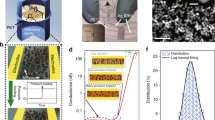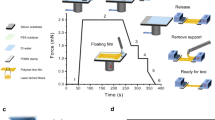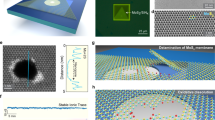Abstract
Highly sensitive sensor arrays are in high demand for prospective applications in remote sensing and imaging. Measuring microscopic deflections of compliant micromembranes and cantilevers is developing into one of the most versatile approaches for thermal, acoustic and chemical sensing. Here, we report on an innovative fabrication of compliant nanocomposite membranes with nanoscale thickness showing extraordinary sensitivity and dynamic range, which makes them candidates for a new generation of membrane-based sensor arrays. These nanomembranes with a thickness of 25–70 nm, which can be freely suspended over large (hundred micrometres) openings are fabricated with molecular precision by time-efficient, spin-assisted layer-by-layer assembly. They are designed as multilayered molecular composites made of a combination of polymeric monolayers and a metal nanoparticle intralayer. We demonstrate that these nanocomposite membranes possess unparalleled sensitivity and a unique autorecovering ability. The membrane nanostructure that is responsible for these outstanding properties combines multilayered polymer/nanoparticle organization, high polymer-chain orientation, and a pre-stretched state.
This is a preview of subscription content, access via your institution
Access options
Subscribe to this journal
Receive 12 print issues and online access
$259.00 per year
only $21.58 per issue
Buy this article
- Purchase on Springer Link
- Instant access to full article PDF
Prices may be subject to local taxes which are calculated during checkout






Similar content being viewed by others
References
Rogalski, A. Infrared detectors: status and trends. Progr. Quant. Electron. 27, 59–210 (2003).
Defay, E., Millon, C., Malhaire, C. & Barbier, D. PZT thin films integration for the realization of a high sensitivity pressure microsensor based on a vibrating membrane. Sens. Actuat. A 99, 64–67 (2002).
Hedrich, F., Billat, S. & Lang, W. Structuring of membrane sensors using sacrificial porous silicon. Sens. Actuat. A 84, 315–323 (2000).
Davidson, J.L., Wur, D.R., Kang, W.P., Kinser, D.L. & Kerns, D.V. Polycrystalline diamond pressure microsensor. Diam. Related Mater. 5, 86–92 (1996).
Timoshenko, S. & Woinowsky-Krieger, S. Theory of Plates and Shells (McGraw-Hill, New York, 1959).
Chévrier, J.B., Baert, K. & Slater, T. An infrared pneumatic detector made by micromachining technology. J. Micromech. Microeng. 5, 193–195 (1995).
Yamashita, K., Murata, A. & Okuyama, M. Miniaturized infrared sensor using silicon diaphragm based on Golay cell. Sens. Actuat. A 66, 29–32 (1998).
Lee, D.R. et al. X-ray scattering from freestanding polymer films with geometrically curved surfaces. Phys. Rev. Lett. 90, 185503 (2003).
Cuvillier, N., Petkova, V., Nedyalkov, M., Millet, F. & Benattar, J.-J. Protein insertion within a biological freestanding film. Physica B 283, 1–5 (2000).
Yablonskii, S.V., Nakano, K., Mikhailov, A.S., Ozaki, M. & Yoshino K. Thermal photodetector using freely suspended liquid-crystal films. Jpn J. Appl. Phys. 42, 198–201 (2003).
Goedel, W.A. & Heger, R. Elastomeric suspended membranes generated via Langmuir-Blodgett transfer. Langmuir 14, 3470–3474 (1998).
Kotov, N.A. Ordered layered assemblies of nanoparticles. Mater. Res. Soc. Bull. 26, 992–997 (2001).
Decher, G. & Schlenoff, J.B. (eds) Multilayer Thin Films (Wiley-VCH, Weinheim, 2003).
Decher, G. Fuzzy nanoassemblies: toward layered polymeric multicomposites. Science 277, 1232–1237 (1997).
Lvov, Y., Decher, G. & Möhwald, H. Assembly, structural characterization, and thermal behavior of layer-by-layer deposited ultrathin films of poly(vinyl sulfate) and poly(allylamine). Langmuir 9, 481–486 (1993).
Tsukruk, V.V. Dendritic macromolecules at interfaces. Adv. Mater. 10, 253–257 (1998).
Cho, J., Char, K., Hong, J.-D. & Lee, K.-B. Fabrication of highly ordered multilayer films using a spin self-assembly method. Adv. Mater. 13, 1076–1078 (2001).
Chiarelli, P.A. et al. Controlled fabrication of polyelectrolyte multilayer thin films using spin-assembly. Adv. Mater. 13, 1167–1171 (2001).
Jiang, C., Markutsya S. & Tsukruk, V.V. Collective and individual plasmon resonances in nanoparticle films obtained by spin-assisted layer-by-layer assembly. Langmuir 20, 882–890 (2004).
Mamedov, A.A. & Kotov, N.A. Free-standing layer-by-layer assembled films of magnetite nanoparticles. Langmuir 16, 5530–5533 (2000).
Mamedov, A.A. et al. Molecular design of strong single-wall carbon nanotube/polyelectrolyte multilayer composites. Nature Mater. l, 190–194 (2002).
Jiang, C., Markutsya, S. & Tsukruk, V.V. Compliant, robust, and truly nanoscale free-standing multilayer films fabricated using spin-assisted layer-by-layer assembly. Adv. Mater. 16, 157–161 (2004).
Neugebauer, C.A., Newkirk, J.B. & Vermilyea, D.A. Structure and Properties of Thin Solid Films (Wiley, New York, 1959).
Jones, R. & Wykes, C. Holographic and Speckle Interferometry: A Discussion of the Theory, Practice and Application of the Techniques (Cambridge Univ. Press, New York, 1983).
Poilane, C., Delobelle, P., Lexcellent, C., Hayashi, S. & Tobushi, H. Analysis of the mechanical behavior of shape memory polymer membranes by nanoindentation, bulging and point membrane deflection tests. Thin Solid Films 379, 156–165 (2000).
Sperling, L.H. Polymeric Multicomponent Materials 37 (Wiley, New York, 1997).
Kovalev, A., Shulha, H., LeMieux, M., Myshkin, N. & Tsukruk V.V. Nanomechanical probing of layered nanoscale polymer films with atomic force microscopy. J. Mater. Res. 19, 716–728 (2004).
Tsukruk, V.V., Shulha, H. & Zhai X. Nanoscale stiffness of individual dendritic molecules and their aggregates. Appl. Phys. Lett. 82, 907–909 (2003).
Yamagata, Y. & Shiratori, S. Evaluation of electrical characteristics of the layer-by-layer self-assembled films after the various annealing temperatures. Thin Solid Films 438–439, 238–242 (2003).
Gao, C., Leporatti, S., Moya, S., Donath, E. & Möhwald, H. Stability and mechanical properties of polyelectrolyte capsules obtained by stepwise assembly of PSS and PAH onto melamine resin particles. Langmuir 17, 3491–3495 (2001).
Dubreuil, F., Elsner, N. & Fery, A. Elastic properties of polyelectrolyte capsules studied by atomic-force microscopy and RICM. Eur. Phys. J. E 12, 215–221 (2003).
Lulevich, V.V., Radtchenko, I.L., Sukhorukov, G.B. & Vinogradova, O.I. Deformation properties of nonadhesive polyelectrolyte microcapsules studied with atomic force microscope. J. Phys. Chem. 107, 2735–2740 (2003).
Vinogradova, O.I., Andrienko, D., Lulevich, V.V., Nordschild, S. & Sukhorukov, G.B. Young's modulus of polyelectrolyte multilayers from microcapsule swelling. Macromolecules 37, 1113–1117 (2004).
Mermut, O., Lefebvre, J., Gray, D.G. & Barrett, C.J. Structural and mechanical properties of polyelectrolyte multilayer films studied by AFM. Macromolecules 36, 8819–8824 (2003).
Fery, A., Dubreuil, F. & Möhwald, H. Mechanics of artificial microscapsules. New J. Phys. 6, 18 (2004).
Vogt, B.D., Soles, C.L., Lee, H., Lin, E.K. & Wu, W. Moisture absorption and absorption kinetics in polyelectrolyte films: influence on film thickness. Langmuir 20, 1453–1458 (2004).
Vlassak, J.J. & Nix, W.D. A new bulge test technique for the determination of Young's modulus and Poisson's ratio of thin films. J. Mater. Res. 7, 3242–3249 (1992).
White, S.R. et al. Autonomic healing of polymer composites. Nature 409, 794–797 (2001).
Tsukruk, V.V. et al. Electrostatic deposition of polyionic mono/bilayers on charged surfaces. Macromolecules 30, 6615–6625 (1997).
Prest, W.M. & Luca, D.J. The origin of the optical anisotropy of solvent cast polymer films. J. Appl. Phys. 50, 6067–6071 (1979).
Law, C.W., Wong, K.S., Yang, Z., Horsburgh, K.S. & Monkman A.P. Observation of in-plane optical anisotropy of spin-cast rigid-rod electroluminescent polymer films. Appl. Phys. Lett. 76, 1416–1418 (2000).
Chiarelli, P.A. et al. Polyelectrolyte spin-assembly. Langmuir 18, 168–173 (2002).
Lee, S.-S., Lee, K.-B. & Hong, J.-D. Evidence for spin coating electrostatic self-assembly of polyelectrolytes. Langmuir 19, 7592–7596 (2003).
Tang, Z., Kotov, N., Magonov, S. & Ozturk, B. Nanostructured artificial nacre. Nature Mater. 2, 413–418 (2003).
Francis, L.F., McCormick, A.V., Vaessen, D.M. & Payne, J.A. Development and measurement of stress in polymer coatings. J. Mater. Sci. 37, 4717–4731 (2002).
Hua, T., Cui, T. & Lvov, Yu. M. Ultrathin cantilevers based on polymer-ceramic nanocomposite assembled through LbL adsorption. Nano Lett. 4, 823–825 (2004).
Zheng, H., Lee, I., Rubner, M. & Hammond, P. Controlled cluster size in patterned particle arrays via directed adsorption on confined surfaces. Adv. Mater. 14, 573–577 (2002).
Grabar, K.C., Freeman, R.G., Hommer, M.B. & Natan, M.J. Preparation and characterization of Au colloid monolayers. Anal. Chem. 67, 735–743 (1995).
Tsukruk, V.V. Scanning probe microscopy of polymer surfaces. Rubber Chem. Technol. 70, 430–475 (1997).
Hazel, J.L. & Tsukruk V.V. Spring constants of composite ceramic/gold cantilevers for scanning probe microscopy. Thin Solid Films 339, 249–257 (1999).
Acknowledgements
This work was supported by the National Science Foundation, CTS-0210005 Grant and the Air Force Office of Science Research, F496200210205 Contract. The authors thank X. Tan and A. Bastawros, Iowa State University and M. R. Beggley, University of Virginia for valuable discussion, F. Laabs and M. Kramer, the Department of Energy Ames Laboratory for access to TEM and assistance with TEM studies, and B. Rybak for assistance with SEM studies.
Author information
Authors and Affiliations
Corresponding author
Ethics declarations
Competing interests
The authors declare no competing financial interests.
Rights and permissions
About this article
Cite this article
Jiang, C., Markutsya, S., Pikus, Y. et al. Freely suspended nanocomposite membranes as highly sensitive sensors. Nature Mater 3, 721–728 (2004). https://doi.org/10.1038/nmat1212
Received:
Accepted:
Published:
Issue Date:
DOI: https://doi.org/10.1038/nmat1212
This article is cited by
-
Conformation-Induced stiffening effect of crosslinked polymer thin films
Communications Physics (2023)
-
Multifactorial engineering of biomimetic membranes for batteries with multiple high-performance parameters
Nature Communications (2022)
-
The role of adsorbates in the green emission and conductivity of zinc oxide
Communications Chemistry (2019)
-
Photosensitive free-standing ultra-thin carbyne–gold films
Optical and Quantum Electronics (2019)
-
Mechanical Properties of Architected Nanomaterials Made from Organic–Inorganic Nanocrystals
JOM (2018)



